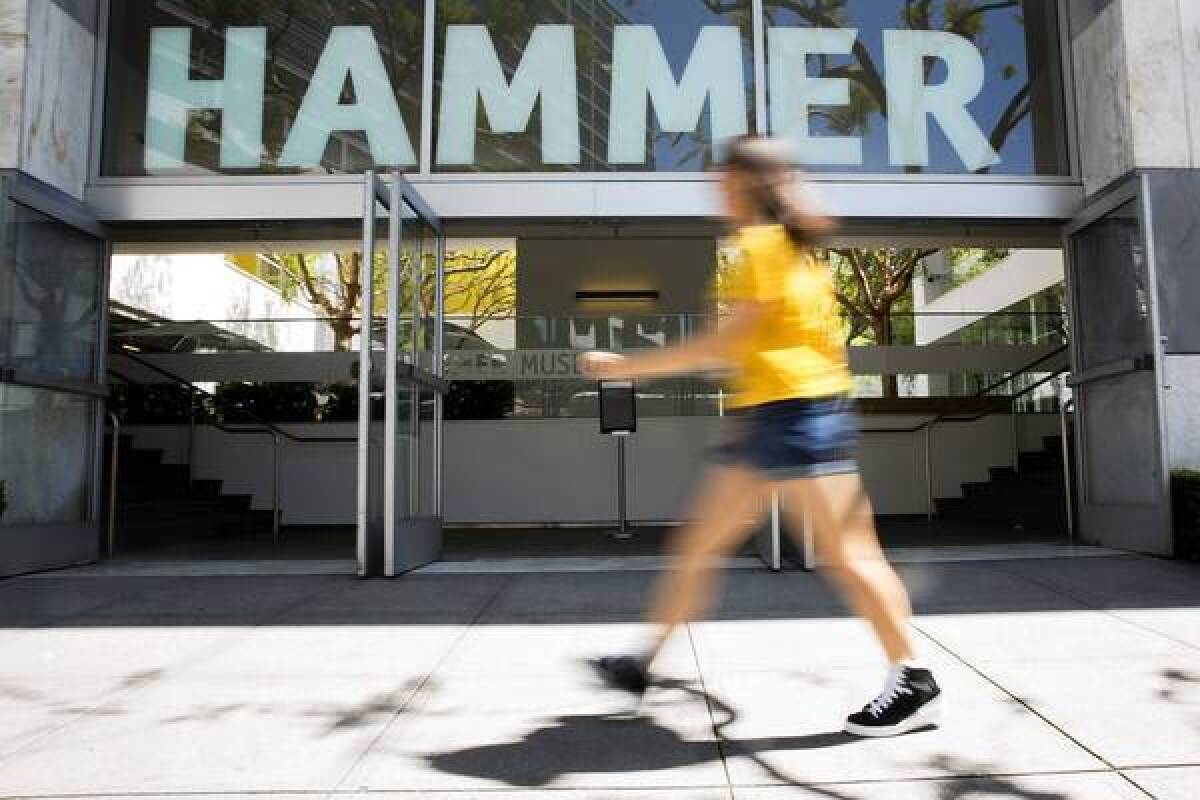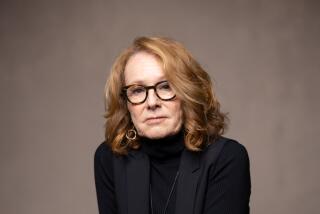UCLA Hammer Museum embraces free admission, and it has company

If a trend requires three of something, then free admission at prominent Los Angeles-area art museums is trembling on the brink of becoming a trend. Museum-wise, few could be better.
At the annual gala of the UCLA Hammer Museum on Saturday night, director Ann Philbin announced that free admission will kick into place at the Westwood institution in February.
Entry to lectures and other Hammer programs, numbering about 250 a year, is already available without charge, while UCLA and other students get free admission to temporary exhibitions and the small permanent collection galleries. Soon that privilege will be extended to everyone, thanks to the generosity of longtime Hammer donors Erika J. Glazer and Brenda R. Potter.
CRITICS’ PICKS: What to watch, where to go, what to eat
The plan has been in the works for several months, and its aim is wider and deeper public engagement with museum offerings. Final details won’t be released before next year. But the Hammer announcement comes fast on the heels of two others.
In September, billionaire businessman Eli Broad announced that when the new museum he is building in downtown Los Angeles to house his art collection opens to the public in 2014, general admission will be free. Some special exhibitions might carry an entrance charge, but a fee to visit the permanent collection, which had been under consideration, was ruled out. The news was welcome.
Shortly before that, the Los Angeles County Museum of Art was revealed as one of three museums across the country that would participate in a study led by the Dallas Museum of Art, which dropped general admission fees to its permanent collection last January. (The Denver Art Museum and the Minneapolis Institute of Arts are the other study participants.) Dallas has unfurled a program called Friends, centered on a free membership card available for the asking.
Like the Hammer goal, it’s designed both to remove financial barriers to attendance and encourage deeper community engagement with the art museum through repeat visits. When a Dallas member goes to an exhibition, attends a program or even participates online in related social media, points are gained. Points can be redeemed for behind-the-scenes tours, shop discounts or even free parking. Think of it as an art museum “frequent flier” program, in which use accrues benefits.
PHOTOS: Arts and culture in pictures by The Times
It remains to be seen what LACMA might end up doing on admissions, which now top out at $25 to $45 for some special exhibitions; the Dallas-led study on visitor participation programs, funded by a federal grant from the Institute of Museum and Library Services, will last two years. Different museums have different economic models — the Minneapolis museum, for instance, already has free general admission, while Denver’s admission varies according to a visitor’s age and resident status — so things can get complicated.
Free admission isn’t always as simple as it sounds, especially when the larger goal is genuine civic engagement. Is there an effect on diversity of attendance? Will it have an impact on other giving? What does it mean for existing categories of membership, which can range from modest rates for individuals to heftier sums for corporate plans?
Since the national financial crisis in 2008, art museums nationwide have seen mostly flat visitor numbers. Changing admission policy is partly designed to deal with that. Repeat attendance, otherwise known as museum loyalty, is also more likely.
Common public perception to the contrary, museum revenue from general admission is usually on the lower end of the financial scale — on average, in the vicinity of just 5% of the annual budget. (In Dallas it amounted to barely 2%; at LACMA in 2010 it was just over 3%.) But it can affect membership income, since museums often promote membership as a cost-effective way to avoid entrance fees. Larger donors also like to look to membership — as well as attendance — to help gauge institutional health.
CHEATSHEET: Fall arts preview 2013
The Hammer has a current operating budget of about $18 million. Annual attendance for permanent collection, special exhibitions and programs stands at about 200,000 — more than respectable for a university museum. Though figures on admissions revenue were not available, the numbers are likely to be below average.
Still, philanthropy will provide a cushion as the transition to free admission goes forward. Glazer, a former real estate and construction executive, sits on the museum’s board of directors. Potter, who serves on Beverly Hills’ Fine Art Commission, has donated works to the Hammer Contemporary Collection. The two benefactors have each pledged $1 million to fund the first four years of the free admission plan.
The Hammer will then join institutions as diverse as the Fowler Museum, its sibling on the nearby UCLA campus; the Santa Monica Museum of Art, which only asks for a suggested donation to see an exhibition; and the sprawling Getty Center, where parking a car is the only charge. Free Hammer admission goes into effect Feb. 9, with the opening of a show that surveys the history of artists’ appropriation of existing images and styles in art and mass media, a technique that became prominent in the 1980s and 1990s.
Fittingly, given the launch, the show is titled “Take It or Leave It: Institution, Image, Ideology.”
Hammer admission, currently topped by a $10 tariff for adults, is not steep. But a move to free entry positions a museum’s artistic program as a public service, not a commercial transaction. In an era when profit-seeking entertainment crowds the field, that distinction is a big deal.
More to Read
The biggest entertainment stories
Get our big stories about Hollywood, film, television, music, arts, culture and more right in your inbox as soon as they publish.
You may occasionally receive promotional content from the Los Angeles Times.











